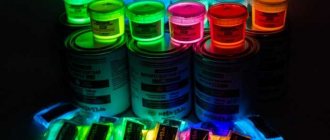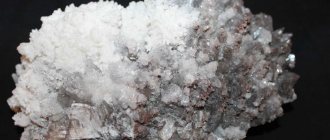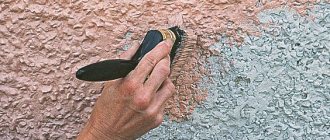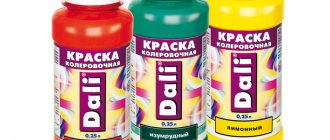Polyvinyl chloride or PVC is a popular material from which many parts, structures and products are made. Over time, the surface of this material wears out, abrasions appear on it, the paint fades, in which case the question arises, how and with what to paint PVC? Sometimes it is necessary to paint metal-plastic windows and doors in a different color so that they fit better into the interior design, or there is a need to protect the surface from destruction and fading. To process smooth PVC, not just any paint will do, especially if you need to paint plastic car parts, a soft inflatable PVC boat, plastic pipes or any other products.
Paint requirements
The main requirement for PVC paint is a high adhesion rate (adhesion to the surface). Polyvinyl chloride differs from wood, brick and concrete in that it has a very smooth and slippery surface, the structure is quite dense and hard, as a result of which plastic cannot be painted with any type of composition. The paint must have the following characteristics and properties:
- resistance to moisture, water;
- high strength;
- resistance to mechanical damage;
- preservation of the shade throughout the entire service life;
- resistance to ultraviolet rays;
- the composition must be environmentally friendly, safe for humans, without toxic, poisonous components that could be released into the air during heating;
- resistance to temperature changes;
- long service life;
- large selection of shades;
- the ability to give the object being painted some kind of texture.
In addition to all the above properties, it is important to choose a composition that you can easily paint with your own hands at home.
Megamarket of paints and technologies
Dear friends! We present to you polyurethane professional paints for PVC.
To begin with, let us recall what products are made from a wonderful polymer - hard and soft PVC (polyvinyl chloride). These are: double-glazed window frames in apartments, window sills, siding, interior doors and fittings, decorative panels for interior and exterior decoration of homes, office equipment housings, advertising luminous blocks, toys, water and sewerage pipes, furniture and inflatable boats, swimming pools, suspended ceilings, banners , awnings, tents and much more. People have individual tastes, and many have a desire to repaint surrounding objects (including PVC) in the desired color. PVC polymer is capricious when it comes to choosing paint for PVC and painting technology. Of course, you can paint PVC with paints and technologies based on organic solvents, but this is expensive and often impossible due to sanitary standards for the use of such paints in residential premises. To solve this problem, water-based polyurethane one-component paints for PVC were specially developed. These wonderful paints do not have a strong odor, they are applied either with a hand tool (tampon, roller, brush) or with pneumatic spray (spray gun) forming an opaque semi-matte coating with a silky sheen, which has high wear resistance and can withstand large changes in temperature and humidity. Polymer paints for PVC have phenomenal adhesion to PVC surfaces and do not require de-glossing or applying an adhesive primer, which significantly saves time and money. Water-soluble paints for PVC can be used by any home craftsman without harm to health, even in a poorly ventilated room; no special skills are required to work with these paints. Dear friends! Our laboratory tints water-soluble paints for rigid PVC in any customer color according to RAL catalogs. Also available in exclusive colors: chameleon, gold, silver, bronze, copper, brass, super bright fluorescent colors.
Dear friends! In the product card for the paint, as well as in the news articles at the bottom of the main page of the site, there are technologies for using paint for PVC. Read, study, and if you have any questions, ask them in the feedback form or by calling the phone numbers on the store’s website.
Order paint carefully. This type of product is individually made and, if of proper quality, cannot be exchanged or returned!
Polyurethane-acrylic paints
These dyes fully comply with all the necessary characteristics, these compositions are made on a water basis, they are often used to paint PVC, for example, plastic windows or other structures. Polyurethane-acrylic mixtures create a uniform coating that is resistant to scratches and other defects. The dye dries quickly enough on the PVC surface; if desired, you can tint the composition yourself. Thanks to these dyes, you can easily and quickly paint PVC, and it is possible to create any textured effects if you add special ingredients to the base paint.
Polyurethane-acrylic paints are made in a huge range of colors; the catalog contains more than two thousand different shades. In addition to traditional colors, manufacturers offer:
- pearlescent paints;
- with sparkles;
- metallic
Using such extraordinary dyes, you can paint any PVC surface in a unique and original way.
Coating protection
Despite the fact that acrylic paints adhere well to the surface of PVC products, they can be further protected using a glossy water-based plastic varnish. In addition to the protective function, it also performs a decorative function, giving the product shine.
This material can be used to treat painted plastic window sills and windows in kitchens, where they are exposed to aggressive factors.
The varnish is applied with a brush and does not require any special skills. Therefore, these works are easy to do with your own hands.
Fire retardant paints, which are often used on metal surfaces, are also suitable for protecting kitchen window sills and pipes running close to open fires.
Preparation before painting
Before painting any PVC product, for example, a window sill, plastic windows, or anything else, it is important to properly prepare the surface. Preparation includes:
- dismantling all structural elements that will interfere with painting. For example, you need to remove the tide, tulle, curtain, blinds, mosquito net and other items from the window;
- any contaminants are removed from the surface, for example, dust, cobwebs, debris, dirt, etc.;
- grease stains are removed using a solvent;
- Construction (painting) tape protects all fittings, rubber seals and other elements so that paint does not get on them. When the painting solution has dried, the masking tape must be removed immediately, otherwise it will be much more difficult to remove it after a few days;
- It is advisable to cover the glass with cellophane film, or you will have to remove the paint from the glass surface with a rag immediately before it dries.
To carry out high-quality, effective cleaning, degrease the surface and remove static stress from it, you can purchase a special activator cleaner in the store, which is designed specifically for PVC. This cleaner is applied to a cloth or rag, and the entire surface is thoroughly wiped with it. After wiping, the composition should completely evaporate, this usually takes about 10 minutes, after which you can paint the PVC with the chosen paint.
If there are scratches, any defects, chips or roughness on the surface, they are covered with a special putty compound, after which the structure is sanded with fine-grained sandpaper. After sanding, it is recommended to treat the PVC with a primer mixture. If you have experience and skills in the field of repair and finishing work, then you can do the filling and sanding yourself, but if you lack experience, it is advisable to seek the services of specialists.
Preliminary work
Before painting, for example, a window sill or window yourself, it is important to prepare the surface well.
To do this it is important to do:
- We remove nets, curtains and anything that may interfere with the normal course of work.
- Remove all dirt.
- Clean off all grease stains.
- All fittings must be covered with special tape to prevent them from being smeared with paint.
- The glass is covered with polyethylene film.
For high-quality cleaning, removing grease and removing static tension, special activators and cleaning products for PVC are often purchased. This product is applied to a rag, and then the base is cleaned with it. Then wait until the entire solution has evaporated, this happens in about 5 - 10 minutes, then you can start painting.
If there are rough areas, unevenness, or scratches on the base, then a primer mixture is applied to the base.
If you have a little experience, you can do it yourself. But without certain skills, it is better to do such a procedure with the help of specialists.
Coloring rules
In order to properly paint metal-plastic windows or plastic car parts made of polyvinyl chloride, it is important to use special paint for PVC, which must be applied with a spray gun. As mentioned earlier, the best option is polyurethane-acrylic paint, which is pre-tinted to the desired shade, mixed thoroughly and poured into the spray gun container.
If, when opening a can of paint, there is a dense film on the surface of the composition, it must be removed, since this film contains solid particles that will not dissolve during mixing; they will quickly clog the spray nozzle. If the paint mixture has been frozen, it is no longer suitable for use, since in the cold the paint and varnish material loses its properties and characteristics, so it is simply thrown away.
Important! To paint PVC products with high quality, you need to choose dry, not hot, sunny weather. If the air temperature is less than +5 degrees, it is not recommended to carry out painting work.
The coloring composition is applied to the surface of a plastic window or other product in a thin, uniform layer, without gaps or drips; the layer thickness should be in the range of 80-120 microns. When using a spray gun, there is no need to first paint corners and hard-to-reach places, because the polyurethane-acrylic composition adheres well to a vertical surface and does not flow from it. After about 3 hours, the dye will already adhere firmly to the plastic, but the completely colored layer will dry only after 2-3 days. For industrial painting, after applying paint and varnish material to a PVC window, accelerated drying is used in special chambers with an air temperature of +50 degrees for 2 hours.
Features of coloring
Knowing what you can use to paint plastic panels, how to prepare them for this, what available means to use for this, you can begin the painting process. Pay attention to these principles:
- Painting work should begin an hour after tinting the paint.
- Before starting painting, it is necessary to determine the viscosity of the composition and, if necessary, dilute the paint with clean water.
- The paint is applied exclusively with a spray gun.
By following the instructions on how to paint panels, you can achieve excellent results. During work, you need to cover the surfaces adjacent to the panels with film so that paint and varnish material is not sprayed on them.
It is necessary to select the optimal parameters of the spray gun, the diameter of the gun nozzle and operating pressure, and also monitor the thickness of the applied layer. You need to spray the dye in a layer of 6 mm. The thinner the coating, the faster it will dry.
Light plastic can be painted in one layer, while dark plastic can be painted twice. To dry the applied paint, the temperature in the room must be at least twenty degrees Celsius. You need to check whether the panels are dry no earlier than after six hours. If you are not satisfied with the color of the panels, it is better to paint them with an acrylic composition.
You can also paint with oil paints, but they have a strong odor. But they can be applied with a brush or roller. You just have to temporarily leave the room in which such paint was used. If there are no practical skills in performing such work, then it is better to entrust the painting of plastic panels to experienced painting specialists who will carry out the painting quickly and efficiently. The quality of the painting depends on the lifespan of the painted panels and the interior design of the room in which they are installed.
What the experts say (2 videos)
PVC panels of different colors (20 photos)
Aerosol cans
If you need to paint a small area of a window or other PVC product, you can purchase paint and varnish material in a can. This form of release is very convenient, thanks to it the paint is reliably protected from air penetration, so that a film never forms on the surface of the composition. Aerosol cans have many advantages:
- ease of transportation;
- You can easily and effortlessly paint small parts and hard-to-reach areas;
- no need to use any additional tools, such as a spray gun or brush;
- dyes in cans have an increased adhesion rate.
Aerosol paints are often used to process PVC automotive parts. In order for the paint coating to be uniform, without drips or gaps, certain skills and dexterity are needed, so first it is important to practice for a few minutes on some unnecessary product, after which, having gained a little experience, you can begin the main painting.
Aerosol paints
If the PVC base that needs to be painted is of a small area, then you can buy a coloring agent in a can. It will be convenient to use because the balloon does not allow air to pass through, so there will definitely be no film inside.
In addition, this paint and varnish material has other advantages:
- Convenient packaging for transportation;
- You can easily paint those places that are difficult to reach, as well as small details;
- No need to buy any tools;
- High level of grip.
Often this type of paint is used to paint plastic parts in the car interior.
In order to apply paintwork in an even layer, you need to practice a little on unnecessary parts to get used to it, and then start the procedure.
Painted surface protection
Although polyurethane-acrylic and polyurethane paints and varnishes adhere well to polyvinyl chloride products, experts recommend additional protection of the painted dried layer. To do this, use special water-based varnishes, used specifically for plastic. In addition to protection, such varnishes create an attractive decorative layer, making the product shiny and beautiful.
You can varnish any painted structures, for example, metal-plastic windows or window sills, especially in places where the products are exposed to adverse factors and aggressive substances. It is advisable to varnish windows from the outside, where they are not affected by high and low temperatures, ultraviolet rays, and precipitation. You can apply the varnish with a regular brush; this does not require any skills or knowledge, so even a beginner in the field of painting can cope with this procedure.
Important! If you need to protect PVC pipes, window sills and other products located near an open fire, it is recommended to paint the surface with a special fire-retardant paint, which is also used for metal structures.
Important nuances
Before purchasing any amount of paint material, you first need to accurately calculate how much paint will be needed. To make a correct calculation, the first step is to take accurate measurements of the product or structure that will be painted. Thanks to the calculation, it is possible to determine the exact area of the object being processed. And if the dye is applied in two layers, then the consumption will accordingly increase by 2 times.
Although the cost of polyurethane and acrylic-urethane paints is quite high, these compositions have very low consumption and a long service life, which more than justifies the high costs of paint and varnish material.
If you need to paint soft PVC fabric, for example, a cover or an inflatable boat, then use the same polyurethane-acrylic paints. However, you must first apply a barrier layer, consisting, for example, of Feyco Universalprimer 2159, diluted with a solvent in a ratio of three to one. This barrier layer is applied from a spray gun with a thin film, its thickness should not exceed 25 microns. After this layer has dried, a polyurethane paint composition is applied.
To paint with high quality, it is important to strictly follow the instructions for applying the composition. For residential premises, be sure to choose paints without harmful, toxic components, made from environmentally friendly raw materials that are safe for human health. It is especially important to select such paints and varnishes if they will be used in medical institutions, children's rooms, and public catering establishments.











